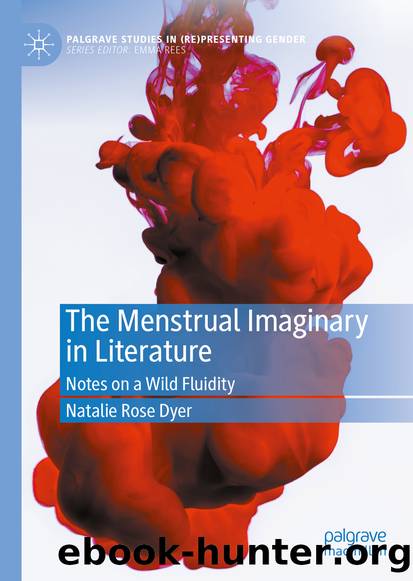The Menstrual Imaginary in Literature by Natalie Rose Dyer

Author:Natalie Rose Dyer
Language: eng
Format: epub
ISBN: 9783030598136
Publisher: Springer International Publishing
You compare your filial bond to various flora and elements, which imbues your maternity with a terrestrial quality. You pay homage to a pre-verbal prosody, a rhythmic knowledge of the child and of his suffering (perhaps more so than his joys), a powerful lasting bodily mediation, which isnât idealised, but rather encapsulated through a highly personal poetic testimony.
Clearly, Julia you desire something beyond the law (of the father), which is related to maternity and equal to oblivion. âOblivion: a blinding, choking, yet tender mistâ (143). As such, a valuable primary nonverbal influence rooted in the orchestrations of the maternal body is given credence in the creative content of your essay âStabat Materââwhich your term âthe semiotic.â You innovatively posit âthis internal graft, this crease inside [between mother and child], which with the cutting of the umbilical cord becomes another personâ (145). You enthuse that women ought to try to remember this frontier of maternal embodiment , that is, the âatoms, molecules, scraps of words, fragments of phrasesâ in which women live (147). Indeed, by elaborating this âinternal graftâ or âcrease of lifeâ in semiotic terms a valuable maternal influence tinged by oblivion, tenderness and love, can be drawn on and written by women at the level of culture. Certainly, your âStabat Materâ anticipates later writings on the semiotic, abjection and maternal eroticism.
In the final part of âStabat Materâ you argue for an ethics of the âmodern age,â which involves âbringing the law flesh, language, and jouissance,â towards an ethical âreformationâ (151). You call for a radical ethical maternity, which is brought to language by women through their psychical drives, or jouissance and is also brought to the law. To some extent you run risk of overly assimilating womenâs flesh and jouissance to a law that would disavow them at every turn Julia (i.e. in keeping with the Lacanian assertion of the power of the symbolic to bring the subject under the law of the father). You argue that âHeretical ethicsâherethicsâmay just be that which makes lifeâs bonds bearable, that which enables us to tolerate thought, and hence the thought of deathâ (152). If the Christian construct of womanhood subsumed under maternity has been represented specifically with respect to the Virgin Mary, whereby according to its vast iconography womenâs sex is an empty shell that can only receive sound, is unable to speak, or indeed give birth to a flow, then your herethics potentially makes enormous tremors in the earthâfrom the other side of the law. Let the law get a massive fright, rupture, be repelled by the powerful mother it senses: she who cannot be contained, controlled, or erased! For a womanâs maternal âinternal graftâ or âcrease insideâ that she may choose to regularly trace and touch on is a psychic threshold related to fluids, animalism and death, which potentially brings forth an enormous flood of poetry. By identifying a frontier of heterogeneous maternal embodiment women can periodically draw on a poetic pre-discursive language that enumerates their multivalent sexual difference (which you term the semiotic).
Download
This site does not store any files on its server. We only index and link to content provided by other sites. Please contact the content providers to delete copyright contents if any and email us, we'll remove relevant links or contents immediately.
The Fine Print (Dreamland Billionaires Book 1) by Lauren Asher(2493)
Fury of Magnus by Graham McNeill(2396)
The Last House on Needless Street by Catriona Ward(2296)
The Rose Code by Kate Quinn(2145)
A Little Life: A Novel by Hanya Yanagihara(1922)
Malibu Rising by Taylor Jenkins Reid(1854)
Luster by Raven Leilani(1844)
Transcendent Kingdom by Yaa Gyasi(1808)
Moonflower Murders by Anthony Horowitz(1794)
The God of the Woods by Liz Moore(1706)
The Lost Book of the White (The Eldest Curses) by Cassandra Clare & Wesley Chu(1613)
This Changes Everything by Unknown(1467)
The Midwife Murders by James Patterson & Richard Dilallo(1435)
The Lying Life of Adults by Elena Ferrante(1393)
The New Wilderness by Diane Cook(1392)
Wandering in Strange Lands by Morgan Jerkins(1371)
Written in the Stars by Alexandria Bellefleur(1355)
Ambition and Desire: The Dangerous Life of Josephine Bonaparte by Kate Williams(1342)
The Lying Life of Adults by Elena Ferrante;(1272)
